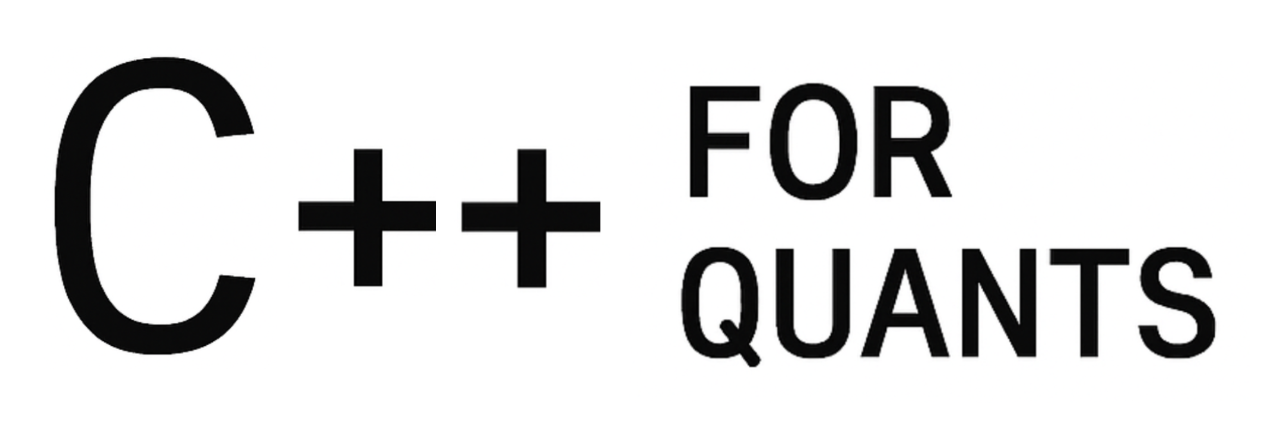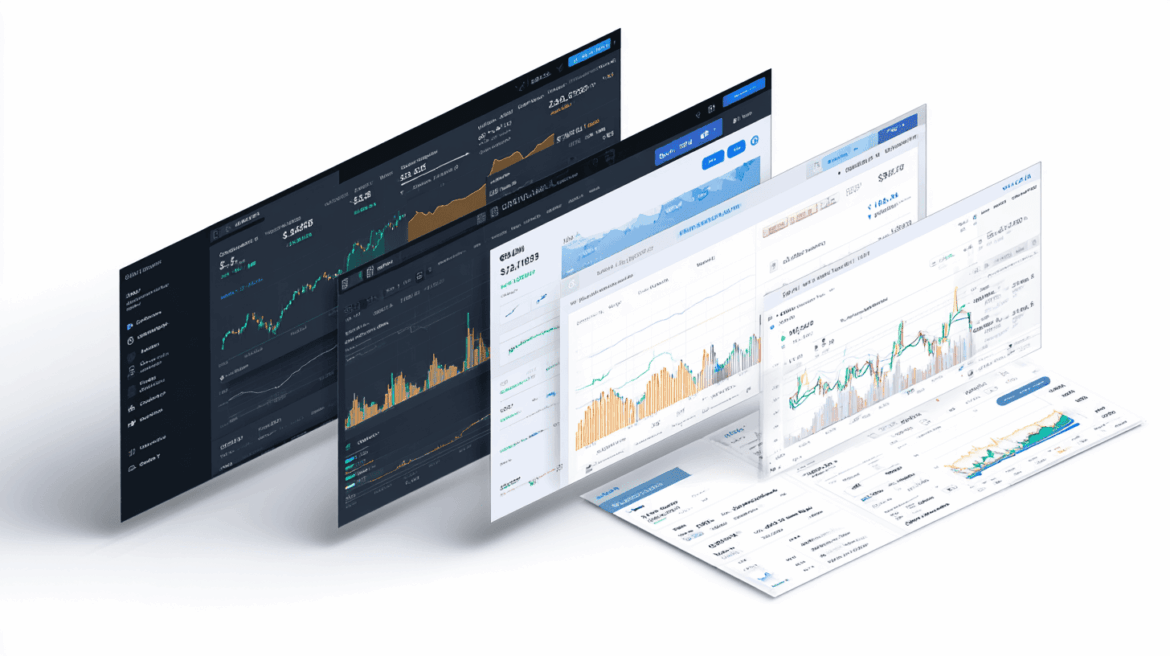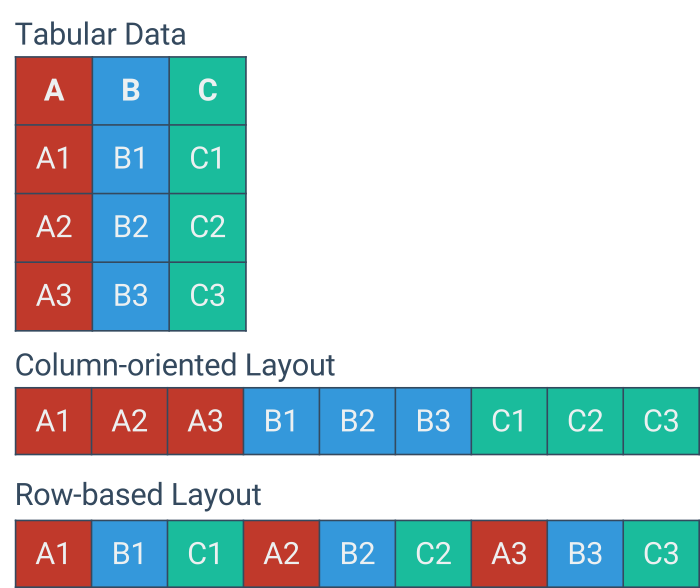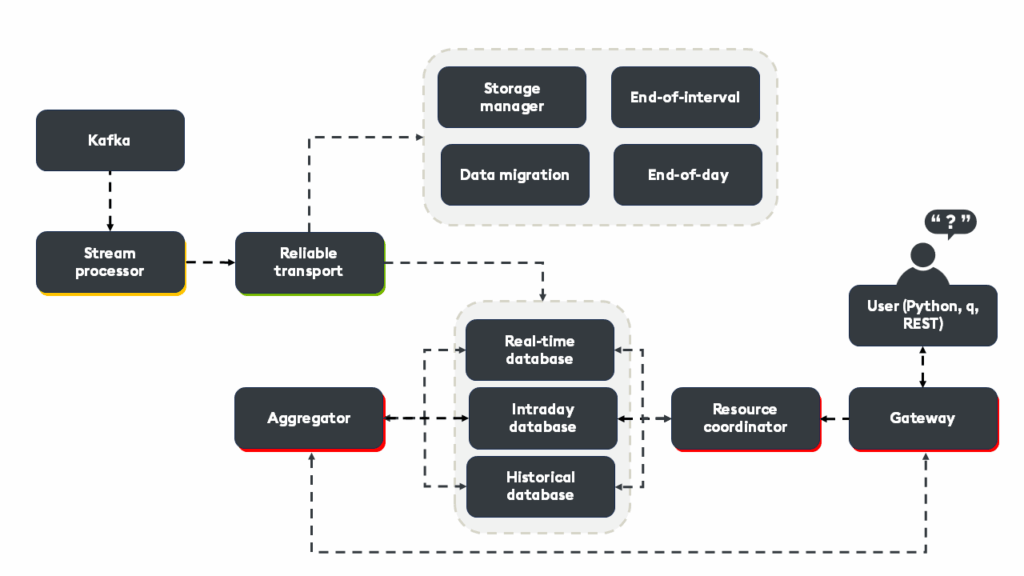This guide provides a comprehensive overview of the entire quant software stack used in global markets: spanning real-time market data, open-source analytics frameworks, front-to-back trading systems, risk engines, OMS/EMS platforms, and execution technology. From Bloomberg and FactSet to QuantLib, Strata, Murex, and FlexTrade, we break down the tools that power pricing, valuation, portfolio management, trading, data engineering, and research. Welcome to the ultimate guide to quant finance software!
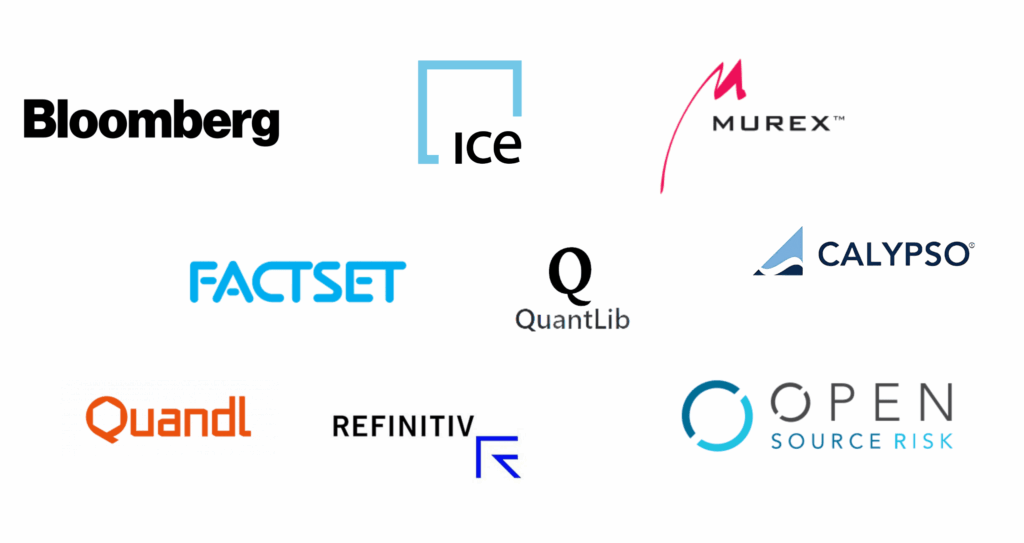
1. Market Data Providers
Market data is the foundation of every quant finance software. From real-time pricing and order-book feeds to evaluated curves, fundamentals, and alternative datasets, these providers supply the core inputs used in pricing models, risk engines, trading systems, and research pipelines. The vendors below represent the most widely used sources of institutional-grade financial data across asset classes.
Bloomberg
Bloomberg is one of the most widely used financial data platforms in global markets, providing real-time and historical pricing, reference data, analytics, and news. Its Terminal, APIs, and enterprise data feeds power trading desks, risk engines, and quant research pipelines across asset classes.
Key Capabilities
- Real-time market data across equities, fixed income, FX, commodities, and derivatives
- Historical time series for pricing, curves, and macroeconomic data
- Reference datasets including corporate actions, fundamentals, and identifiers
- Bloomberg Terminal tools for analytics, charting, and trading workflows
- Enterprise data feeds (BPIPE) for low-latency connectivity
- API & SDK access for Python, C++, and other languages (BLPAPI)
Typical Quant/Engineering Use Cases
- Pricing & valuation models
- Curve construction and calibration
- Risk factor generation
- Time-series research and statistical modelling
- Backtesting & market data ingestion
- Integration with execution and OMS systems
Supported Languages
C++, Python, Java, C#, via clients, REST APIs and connectors.
Official Resources
FactSet
FactSet is a comprehensive financial data and analytics platform widely used by institutional investors, asset managers, quants, and risk teams. It provides global market data, fundamental datasets, portfolio analytics, screening tools, and an extensive API suite that integrates directly with research and trading workflows.
Key Capabilities
- Global equity and fixed income pricing
- Detailed company fundamentals, estimates, and ownership data
- Portfolio analytics and performance attribution
- Screening and factor modelling tools
- Real-time and historical market data feeds
- FactSet API, SDKs, and data integration layers
Typical Quant/Engineering Use Cases
- Equity and multi-asset factor research
- Time-series modelling and forecasting
- Portfolio construction and optimization
- Backtesting with fundamental datasets
- Performance attribution & risk decomposition
- Data ingestion into quant pipelines and research notebooks
Supported Languages
Python, R, C++, Java, .NET, via clients, REST APIs and connectors.
Official Resources
Developer Documentation
Product Overview Pages
Factset Workstation
ICE
ICE Data Services provides real-time and evaluated market data, fixed income pricing, reference data, and analytics used across trading desks, risk systems, and regulatory workflows. Known for its deep coverage of credit and rates markets, ICE is a major provider of bond evaluations, yield curves, and benchmark indices used throughout global finance.
Key Capabilities
- Evaluated pricing for global fixed income securities
- Real-time and delayed market data across asset classes
- Reference and corporate actions data
- Yield curves, volatility surfaces, and benchmarks
- Index services (e.g., ICE BofA indices)
- Connectivity solutions and enterprise data feeds
- Regulatory & transparency datasets (MiFID II, TRACE)
Typical Quant/Engineering Use Cases
- Bond pricing, fair-value estimation, and curve construction
- Credit risk modelling (spreads, liquidity, benchmarks)
- Backtesting fixed income strategies
- Time-series research on rates and credit products
- Regulatory and compliance reporting
- Feeding risk engines & valuation models with evaluated pricing
Supported Languages
Python, C++, Java, .NET, REST APIs (via ICE Data Services platforms).
Official Resources
ICE Website
ICE Data Analytics
ICE Fixed Income and Data Services
Refinitiv (LSEG)
Refinitiv (LSEG Data & Analytics) is one of the largest global providers of financial market data, analytics, and trading infrastructure. Offering deep cross-asset coverage, Refinitiv delivers real-time market data, historical timeseries, evaluated pricing, and reference data used by quants, risk teams, traders, and asset managers. Through flagship platforms like DataScope, Workspace, and the Refinitiv Data Platform (RDP), it provides high-quality data across fixed income, equities, FX, commodities, and derivatives.
Key Capabilities
- Evaluated pricing for global fixed income, including complex OTC instruments
- Real-time tick data across equities, FX, fixed income, commodities, and derivatives for quant finance software
- Deep reference data, symbology, identifiers, and corporate actions
- Historical timeseries & tick history (via Refinitiv Tick History)
- Yield curves, vol surfaces, term structures, and macroeconomic datasets
- Powerful analytics libraries via Refinitiv Data Platform APIs
- Enterprise data feeds (Elektron, Level 1/Level 2 order books)
- Regulatory and transparency datasets (MiFID II, trade reporting, ESG disclosures)
Typical Quant/Engineering Use Cases
- Cross-asset pricing and valuation for bonds, FX, and derivatives
- Building yield curves, vol surfaces, and factor models
- Backtesting systematic strategies using high-quality historical tick data
- Time-series research across macro, commodities, and rates
- Risk modelling, sensitivity analysis, stress testing
- Feeding risk engines, intraday models, and trading systems with normalized data
- Regulatory reporting workflows (MiFID II, RTS, ESG)
- Data cleaning, mapping, and symbology-resolution for quant pipelines
Supported Languages
Python, C++, Java, .NET, REST APIs, WebSocket APIs
(primarily delivered via Refinitiv Data Platform, Elektron APIs, and Workspace APIs
Official Resources
- Refinitiv Website (LSEG Data & Analytics)
- Refinitiv Data Platform (RDP) APIs
- Refinitiv Tick History
- Refinitiv Workspace
Quandl
Quandl (Nasdaq Data Link) is a leading data platform offering thousands of financial, economic, and alternative datasets through a unified API. Known for its clean delivery format and wide coverage, Quandl provides both free and premium datasets ranging from macroeconomics, equities, and futures to alternative data like sentiment, corporate fundamentals, and crypto. Now part of Nasdaq, it powers research, quant modelling, and data engineering workflows across hedge funds, asset managers, and fintechs.
Key Capabilities
- Unified API for thousands of financial & alternative datasets
- Macroeconomic data, interest rates, central bank series, and indicators
- Equity prices, fundamentals, and corporate financials
- Futures, commodities, options, and sentiment datasets
- Alternative data (consumer behaviour, supply chain, ESG, crypto)
- Premium vendor datasets from major providers
- Bulk download & time-series utilities for research pipelines
- Integration with Python, R, Excel, and server-side apps
Typical Quant/Engineering Use Cases
- Factor research & systematic strategy development
- Macro modelling, global indicators, and regime analysis
- Backtesting equity, rates, and commodities strategies for quant finance software
- Cross-sectional modelling using fundamentals
- Alternative-data-driven alpha research
- Portfolio analytics and macro-linked risk modelling
- Building data ingestion pipelines for quant research
- Academic quantitative finance research
Supported Languages
Python, R, Excel, Ruby, Node.js, MATLAB, Java, REST APIs
Official Resources
Nasdaq Data Link Website
Quandl API Documentation
Nasdaq Alternative Data Products
2.Developer Tools & Frameworks
QuantLib
QuantLib is the leading open-source quantitative finance library, widely used across banks, hedge funds, fintechs, and academia for pricing, curve construction, and risk analytics. A quant finance software classic! Built in C++ with extensive Python bindings, QuantLib provides a comprehensive suite of models, instruments, and numerical methods covering fixed income, derivatives, optimization, and Monte Carlo simulation. Its transparency, flexibility, and industry alignment make it a foundational tool for prototyping trading models, validating pricing engines, and building production-grade quant frameworks.
Key Capabilities
- Full fixed income analytics: yield curves, discounting, bootstrapping
- Pricing engines for swaps, options, exotics, credit instruments
- Stochastic models (HJM, Hull–White, Black–Karasinski, CIR, SABR, etc.)
- Volatility surfaces, smile interpolation, variance models
- Monte Carlo, finite differences, lattice engines
- Calendars, day-count conventions, schedules, market conventions
- Robust numerical routines (root finding, optimization, interpolation)
Typical Quant/Engineering Use Cases
- Pricing vanilla & exotic derivatives
- Building multi-curve frameworks and volatility surfaces
- Interest-rate modelling and calibration
- XVA prototyping and risk-sensitivity analysis
- Monte Carlo simulation for structured products
- Backtesting and scenario generation
- Teaching, research, and model validation for quant finance software
- Serving as a pricing microservice inside larger quant platforms
Supported Languages
C++, Python (via SWIG bindings), R, .NET, Java, Excel add-ins, command-line tools
Official Resources
QuantLib Website
QuantLib Python Documentation
QuantLib GitHub Repository
Finmath
Finmath is a comprehensive open-source quant finance software library written in Java, designed for modelling, pricing, and risk analytics across derivatives and fixed income markets. It provides a modular architecture with robust implementations of Monte Carlo simulation, stochastic processes, interest-rate models, and calibration tools. finmath is widely used in academia and industry for its clarity, mathematical rigor, and ability to scale into production systems where JVM stability and performance are required.
Key Capabilities
- Monte Carlo simulation framework (Brownian motion, Lévy processes, stochastic meshes)
- Interest-rate models: Hull–White, LIBOR Market Model (LMM), multi-curve frameworks
- Analytic formulas for vanilla derivatives, caps/floors, and swaps
- Calibration engines for stochastic models and volatility structures
- Automatic differentiation and algorithmic differentiation tools
- Support for stochastic volatility, jump-diffusion, and hybrid models
- Modular pricers for structured products and exotic payoffs
- Excel, JVM-based servers, and integration with big-data pipelines
Typical Quant/Engineering Use Cases
- Monte Carlo pricing of path-dependent and exotic derivatives
- LMM and Hull–White calibration for rates desks
- Structured products modelling and scenario analysis
- XVA and exposure simulations using forward Monte Carlo
- Risk factor simulation for regulatory stress testing
- Model validation and prototyping in Java-based environments
- Educational use for teaching stochastic calculus and derivatives pricing
Supported Languages
Java (core), with interfaces usable from Scala, Kotlin, and JVM-based environments; optional Excel integrations
Official Resources
finmath Library Website
finmath GitHub Repository
finmath Documentation & Tutorials
Strata
OpenGamma Strata is a modern, production-grade open-source analytics library for pricing, risk, and market data modelling across global derivatives markets. Written in Java and designed with institutional robustness in mind, Strata provides a complete framework for building and calibrating curves, volatility surfaces, interest-rate models, FX/credit analytics, and standardized market conventions. It is used widely by banks, clearing houses, and fintech platforms to power high-performance valuation services, regulatory risk calculations, and enterprise quant finance software infrastructure.
Key Capabilities
- Full analytics for rates, FX, credit, and inflation derivatives
- Curve construction: OIS, IBOR, cross-currency, inflation, basis curves
- Volatility surfaces: SABR, Black, local vol, swaption grids
- Pricing engines for swaps, options, swaptions, FX derivatives, CDS
- Market conventions, calendars, day-count standards, trade representations
- Robust calibration and scenario frameworks
- Portfolio-level risk: PV, sensitivities, scenario shocks, regulatory measures
- Built-in serialization, market data containers, and workflow abstractions
Typical Quant/Engineering Use Cases
- Pricing and hedging of rates, FX, and credit derivatives
- Building multi-curve frameworks for trading and risk
- Market data ingestion and transformation pipelines
- XVA inputs: sensitivities, surfaces, curves, calibration tools
- Regulatory reporting (FRTB, SIMM, margin calculations)
- Risk infrastructure for clearing, margin models, and limit frameworks
- Enterprise-grade pricing microservices for front office and risk teams
- Model validation and backtesting for derivatives portfolios
Supported Languages
Java (core), Scala/Kotlin via JVM interoperability, with REST integrations for enterprise deployment
Official Resources
OpenGamma Strata Website
Strata GitHub Repository
Strata Documentation & Guides
OpenGamma Blog & Technical Papers
ORE (Open-Source Risk Engine)
ORE (Open-Source Risk Engine) is a comprehensive open-source risk and valuation platform built on top of QuantLib. Developed by Acadia, ORE extends QuantLib from a pricing library into a full multi-asset risk engine capable of portfolio-level analytics, scenario-based valuation, XVA, stress testing, and regulatory risk. Written in modern C++, ORE introduces standardized trade representations, market conventions, workflow orchestration, and scalable valuation engines suitable for both research and production environments. Designed to bridge the gap between quant model development and enterprise-grade risk systems, ORE is used across banks, derivatives boutiques using quant finance software, consultancies, and academia to prototype or run real-world risk pipelines. Its modular architecture and human-readable XML inputs make it accessible for quants, engineers, and risk managers alike.
Key Capabilities
Full portfolio valuation and risk analytics: multi-asset support, standardized trade representation, market data loaders, curve builders
XVA analytics: CVA, DVA, FVA, LVA, KVA; CSA modelling and collateral simulations
Scenario-based simulation: historical and hypothetical stress tests, Monte Carlo P&L distribution, bucketed sensitivities
Risk aggregation & reporting: NPV, DV01, CS01, vega, gamma, curvature, regulatory risk (SIMM via extensions)
Production-ready workflows: XML configuration, batch engines, logging, audit reports
Typical Quant/Engineering Use Cases
Building internal XVA analytics
Prototyping bank-grade risk engines
Scenario analysis and stress testing
Independent price verification (IPV) and model validation
Collateralized curve construction
Portfolio-level aggregation and risk decomposition
Large-scale Monte Carlo simulation for quant finance software
Integrating QuantLib pricing into enterprise workflows
Teaching advanced risk and valuation concepts
Supported Languages
C++ (core engine)
Python (community bindings)
XML workflow/configuration
JSON/CSV inputs and outputs
Official Resources
ORE GitHub Repository
ORE DocumentationORE User Guide
3.Front-to-Back Trading & Risk Platforms
Murex
Murex (MX.3) is the world’s leading front-to-back trading, risk, and operations platform used by global banks, asset managers, insurers, and clearing institutions. Known as the industry’s most comprehensive cross-asset system, Murex unifies trading, pricing, market risk, credit risk, collateral, PnL, and post-trade operations into a single integrated architecture. It is considered the “gold standard” for enterprise-scale capital markets infrastructure and remains the backbone of trading desks across interest rates, FX, equities, credit, commodities, and structured products. Built around a modular, high-performance calculation engine, MX.3 supports pre-trade analytics, trade capture, risk measurement, lifecycle management, regulatory reporting, and settlement workflows. Quants and developers frequently interface with Murex via its model APIs, scripting capabilities, and market data pipelines, making it a central component of real-world quant finance software.
Key Capabilities
Front-office analytics: real-time pricing, RFQ workflows, limit checks, scenario tools
Cross-asset trade capture: IR, FX, credit, equity, commodity, hybrid & structured products
Market risk: VaR, sensitivities (Greeks), stress testing, FRTB analytics
XVA & credit risk: CVA/DVA/FVA/MVA/KVA with CSA & netting-set modelling
Collateral & treasury: margining, inventory, funding optimization, liquidity risk
Middle & back office: confirmations, settlements, accounting, reconciliation
Enterprise data management: curves, surfaces, workflow orchestration, audit trails
High-performance computation layer: distributed risk runs, batch engines, grid scheduling
Typical Quant/Engineering Use Cases
Integrating custom pricing models and curves
Building pre-trade analytics and scenario tools for trading desks
Extracting market data, risk data, and PnL explain feeds
Setting up or validating XVA, FRTB, and regulatory risk workflows
Automating lifecycle events for structured and exotic products
Connecting Murex to in-house quant finance software libraries (QuantLib, ORE, proprietary C++ pricers)
Developing risk dashboards, overnight batch pipelines, and stress-testing frameworks
Supporting bank-wide migrations (e.g., MX.2 → MX.3, LIBOR transition initiatives)
Supported Languages & Integration
C++ for model integration and high-performance pricing components
Java for workflow extensions and service layer integration
Python for analytics, ETL, and data extraction via APIs
SQL for reporting and data interrogation
XML for configuration of trades, market data, workflows, and static data
Official Resources
Murex Website
Murex Knowledge Hub (client portal)
MX.3 Product Overview for Banks
Calypso
A unified front-to-back trading, risk, collateral, and clearing platform widely adopted by global banks, central banks, clearing houses, and asset managers. Calypso (now part of Adenza, following the merge with AxiomSL) is known for its strong coverage of derivatives, securities finance, treasury, and post-trade operations for quant finance software. It provides an integrated architecture across trade capture, pricing, risk analytics, collateral optimization, and regulatory reporting, making it a common choice for institutions seeking a modular, standards-driven system.
With a flexible Java-based framework, Calypso supports extensive customization through APIs, workflow engines, adapters, and data feeds for quant finance software. It is particularly strong in clearing, collateral management, treasury operations, and real-time event processing, making it a critical component in many bank infrastructures.
Key Capabilities
Front-office analytics: real-time valuation, pricing, trade validation, limit checks, pre-trade workflows
Cross-asset trade capture: linear/non-linear derivatives, securities lending, repos, treasury & funding products
Market risk: Greeks, VaR, stress testing, historical/MC simulation, FRTB analytics
Credit & counterparty risk: PFE, CVA/DVA, SA-CCR, IMM, netting set modelling
Collateral & clearing: enterprise margining, eligibility schedules, CCP connectivity, triparty workflows
Middle & back office: confirmations, settlements, custody, corporate actions, accounting
Enterprise integration: MQ/JMS/REST adapters, data dictionaries, workflow orchestration, regulatory reporting
Performance & computation layer: distributed risk runs, event-driven processing, batch scheduling
Typical Quant/Engineering Use Cases
Integrating custom pricers and analytics into the Java pricing framework
Building pre-trade risk tools and scenario screens for trading desks
Extracting market, risk, and PnL data for downstream analytics
Implementing or validating XVA, SA-CCR, and regulatory capital workflows
Automating collateral optimization and eligibility logic for enterprise CCP flows
Connecting Calypso to in-house quant libraries (Java, Python, C++)
Developing real-time event listeners for lifecycle, margin, and clearing events
Supporting migrations and upgrades (Calypso → Adenza cloud, major version upgrades)
Official Resources
FIS
FIS is a long-established, cross-asset trading, risk, and operations platform used extensively by global banks, asset managers, and treasury departments. Known for its robust handling of interest rate and FX derivatives, Summit provides a unified environment spanning trade capture, pricing, risk analytics, collateral, treasury, and back-office processing. Despite being considered a legacy platform by many institutions, Summit remains deeply embedded in the infrastructure of Tier-1 and Tier-2 banks due to its stability, extensive product coverage, and mature STP workflows.
Built around a performant C++ core with a scripting layer (SML) and flexible integration APIs, Summit supports custom pricing models, automated batch processes, and data pipelines for both intraday and end-of-day operations. It is commonly found in banks undergoing modernization projects, cloud migrations, or system consolidation from older vendor stacks.
Key Capabilities
Front-office analytics: pricing for IR/FX derivatives, scenario analysis, position management
Cross-asset trade capture: rates, FX, credit, simple equity & commodity derivatives, money markets
Market risk: Greeks, sensitivities, VaR, stress tests, scenario shocks
Counterparty risk: PFE, CVA, exposure profiles, netting-set logic
Treasury & funding: liquidity management, cash ladders, intercompany funding
Middle & back office: confirmations, settlement instructions, accounting rules, GL integration
Collateral & margining: margin call workflows, eligibility checks, CCP/tiered clearing
Enterprise integration: SML scripts, C++ extensions, MQ/JMS connectors, batch & EOD scheduling
Performance layer: optimized C++ engine for large books, distributed batch calculations
Typical Quant/Engineering Use Cases
Integrating custom pricing functions through C++ or SML extensions
Building pre-trade risk tools, limit checks, and scenario pricing screens
Extracting risk sensitivities, exposure profiles, and PnL explain feeds for analytics
Validating credit exposure, CVA, and regulatory risk data (SA-CCR, IMM)
Automating treasury and liquidity workflows for money markets and funding books
Connecting Summit to in-house quant libraries (C++, Python, Java adapters)
Developing batch frameworks for EOD risk, PnL, data cleaning, and reconciliation
Supporting modernization programs (Summit → Calypso/Murex migration, cloud uplift, architecture rewrites)
Blackrock Aladdin
BlackRock Aladdin is an enterprise-scale portfolio management, risk analytics, operations, and trading platform used by asset managers, pension funds, insurers, sovereign wealth funds, and large institutional allocators. Known as the industry’s most powerful buy-side risk and investment management system, Aladdin integrates portfolio construction, order execution, analytics, compliance, performance, and operational workflows into a unified architecture.
Originally built to manage BlackRock’s own portfolios, Aladdin has evolved into a global operating system for investment management, delivering multi-asset risk analytics, scalable data pipelines, and tightly integrated OMS/PMS capabilities. With its emphasis on transparency, scenario analysis, and factor-based risk modelling, Aladdin has become a critical platform for institutions seeking consistency across risk, performance, and investment decision-making.
Aladdin’s open APIs, data feeds, and integration layers allow quants and engineers to plug into portfolio, reference, pricing, and factor data, making it a core component of enterprise buy-side infrastructures.
Key Capabilities
Portfolio management: construction, optimisation, rebalancing, factor exposures, performance attribution
Order & execution management (OMS): multi-asset trading workflows, pre-trade checks, compliance, routing
Risk analytics: factor models, stress tests, scenario engines, historical & forward-looking risk
Market risk & exposures: VaR, sensitivities, stress shocks, liquidity analytics
Compliance & controls: rule-based pre/post-trade checks, investment guidelines, audit workflows
Data management: pricing, curves, factor libraries, ESG data, holdings, benchmark datasets
Operational workflows: trade settlements, reconciliations, corporate actions
Aladdin Studio: development environment for custom analytics, Python notebooks, modelling pipelines
Enterprise integration: APIs, data feeds, reporting frameworks, cloud-native distribution
Typical Quant/Engineering Use Cases
Integrating custom factor models, stress scenarios, and risk methodologies into the Aladdin ecosystem
Building portfolio optimisation tools and bespoke analytics through Aladdin Studio
Connecting Aladdin to internal quant libraries, Python environments, and research pipelines
Extracting holdings, benchmarks, factor exposures, risk metrics, and P&L explain data
Developing compliance engines, rule libraries, and pre-trade limit workflows
Automating reporting, reconciliation, and operational pipelines for large asset managers
Implementing ESG analytics, liquidity risk screens, and regulatory reporting tools
Supporting enterprise-scale migrations onto Aladdin’s cloud-native environment
4.Execution & Trading Systems
Fidessa (ION)
Fidessa is the industry’s benchmark execution and order management platform for global equities, listed derivatives, and cash markets. Used by investment banks, brokers, exchanges, market makers, and large hedge funds, Fidessa delivers high-performance electronic trading, deep market connectivity, smart order routing, and algorithmic execution in a unified environment. Known for its ultra-reliable infrastructure and resilient trading architecture, Fidessa provides access to hundreds of exchanges, MTFs, dark pools, and broker algos worldwide. Its real-time market data feeds, FIX gateways, compliance engine, and execution analytics make it a foundational component of electronic trading desks. Now part of ION Markets, Fidessa remains one of the most widely deployed platforms for high-touch and low-touch equity trading, offering a robust framework for custom execution strategies and global routing logic.
Key Capabilities
Order & execution management (OMS/EMS): multi-asset order handling, care orders, low-touch flows, parent/child order management
Market connectivity: direct exchange connections, MTFs, dark pools, broker algorithms, smart order routing
Real-time market data: depth, quotes, trades, tick data, venue analytics
Algorithmic trading: strategy containers, broker algo integration, SOR logic, internal crossing
Compliance & risk controls: limit checks, market abuse monitoring, MiFID reporting, pre-trade risk
Trading workflows: high-touch blotters, sales-trader workflows, DMA tools, program trading
Back-office & operations: allocations, matching, confirmations, trade reporting
FIX infrastructure: FIX gateways, routing hubs, drop copies, OMS → EMS workflows
Performance & scalability: fault-tolerant architecture, high-availability components, low-latency market access
Typical Quant/Engineering Use Cases
Building and deploying custom algorithmic trading strategies in Fidessa’s execution framework
Integrating smart order routing logic and multi-venue liquidity analytics
Connecting Fidessa OMS to downstream risk engines, pricing models, and TCA tools
Developing real-time market data adapters, FIX gateways, and trade feed processors
Automating compliance checks, MiFID reporting, and surveillance workflows
Extracting tick data, executions, and quote streams for analytics and model calibration
Supporting program trading desks with custom basket logic and volatility-aware strategies
Managing large-scale migrations into ION’s unified trading architecture
FlexTrade (FlexTRADER)
FlexTrade’s FlexTRADER is a flagship multi-asset execution management system (EMS) designed for quantitative trading desks, asset managers, hedge funds, and sell-side execution teams. Known as one of the most customizable and algorithmically sophisticated EMS platforms, FlexTRADER provides advanced order routing, execution algorithms, real-time analytics, and seamless integration with in-house quant models.
FlexTrade distinguishes itself through its open architecture, API-driven design, and deep support for automated and systematic execution workflows. It enables institutions to build custom execution strategies, incorporate proprietary signals, integrate model-driven routing logic, and connect to liquidity across global equities, FX, futures, fixed income, and options markets. Its strong TCA tools and high configurability make it a favourite among quant, systematic, and low-latency execution teams.
Key Capabilities
Multi-asset execution: equities, FX, futures, options, fixed income, ETFs, derivatives
Algorithmic trading: broker algos, native Flex algorithms, fully custom strategy containers
Smart order routing (SOR): liquidity-seeking, schedule-based, cost-optimised routing
Real-time analytics: market impact, slippage, venue heatmaps, liquidity curves
TCA & reporting: pre-trade, real-time, and post-trade analytics with benchmark comparisons
Order & workflow management: portfolio trading, pairs trading, block orders, basket execution
Connectivity: direct market access (DMA), algo wheels, liquidity providers, dark/alternative venues
Integration APIs: Python, C++, Java, FIX, data adapters for quant signals and simulation outputs
Customisation layer: strategy scripting, UI configuration, event-driven triggers, automation rules
Typical Quant/Engineering Use Cases
Integrating proprietary execution algorithms, signals, and cost models into FlexTRADER
Developing custom SOR logic using internal market impact models
Building automated execution pipelines driven by alpha models or risk signals
Feeding FlexTrade real-time analytics into research workflows and intraday dashboards
Connecting FlexTRADER to quant libraries (Python/C++), backtesting engines, and ML-driven routing models
Automating multi-venue liquidity capture, dark pool interaction, and broker algo selection
Creating real-time TCA analytics and execution diagnostics for systematic trading teams
Supporting global multi-asset expansion, co-location routing, and high-performance connectivity
Bloomberg EMSX (Electronic Market)
Bloomberg EMSX is the embedded execution management system within the Bloomberg Terminal, providing multi-asset trading, broker algorithm access, smart routing, and real-time analytics for institutional investment firms, hedge funds, and trading desks. As one of the most widely used execution platforms in global markets, EMSX offers seamless integration with Bloomberg’s market data, analytics, news, portfolio tools, and compliance engines, making it a central component of daily trading workflows. EMSX supports equities, futures, options, ETFs, and FX workflows, enabling traders to route orders directly from Bloomberg screens such as MONITOR, PORT, BDP, and custom analytics. Its native access to broker algorithms, liquidity providers, and execution venues—combined with Bloomberg’s unified data ecosystem—makes EMSX a powerful tool for low-touch trading, portfolio execution, and workflow automation across asset classes.
Key Capabilities
Multi-asset execution: equities, ETFs, futures, options, and FX routing
Broker algorithm access: direct integration with global algo suites (VWAP, POV, liquidity-seeking, schedule-driven)
Order & workflow management: parent/child orders, baskets, care orders, DMA routing
Real-time analytics: slippage, benchmark comparisons, market impact indicators, TCA insights
Portfolio trading: basket construction, rebalancing tools, program trading workflows
Integration with Bloomberg ecosystem: PORT, AIM, BQuant, BVAL, market data, research, news
Compliance & controls: pre-trade checks, regulatory rules, audit trails, trade reporting
Connectivity: FIX routing, broker connections, smart order routing, dark/alternative venue access
Automation & scripting: rules-based workflows, event triggers, Excel API and Python integration
Typical Quant/Engineering Use Cases
Automating low-touch execution workflows directly from Bloomberg analytics (e.g., PORT → EMSX)
Integrating broker algo selection and routing decisions into quant-driven strategies
Extracting execution, tick, and benchmark data for TCA, slippage modelling, or market impact analysis
Connecting EMSX flows to internal OMS/EMS platforms (FlexTrade, CRD, Eze, proprietary systems)
Developing Excel, Python, or BQuant-driven automation pipelines for execution and monitoring
Embedding pre-trade analytics, compliance checks, and liquidity models into EMSX order workflows
Supporting global routing, basket trading, and cross-asset execution for institutional portfolios
Leveraging Bloomberg’s unified data (fundamentals, pricing, factor data, corporate actions) for model-based trading pipelines
